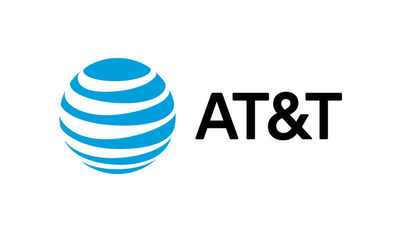AT&T Delivers Strong 2023 Results, Cash from Operations and Free Cash Flow Driven by 5G and Fiber Growth
AT&T's multi-year, investment-led strategy delivers improved free cash flow as company attracts and retains profitable customers
Solid fourth-quarter results and strong free cash flow close out a strong year
- Fourth quarter cash from operating activities of
$11.4 billion $1.0 billion 10.0% year over year; Full-year cash from operating activities of$38.3 billion $2.5 billion - Fourth quarter free cash flow* of
$6.4 billion $16.8 billion $2.6 billion - Fourth quarter revenues of
$32.0 billion 2.2% year over year. - Fourth quarter operating income of
$5.3 billion $5.8 billion $23.5 billion $24.7 billion 5.0% year over year.
"We accomplished exactly what we said we would in 2023, delivering sustainable growth and consistent business performance, resulting in full-year free cash flow of
Strategy enables profitable 5G and fiber subscriber growth
- Full-year Mobility service revenues up
4.4% , above guidance; company's best-ever full-year Mobility operating income. - Full-year consumer broadband revenues up
8.1% , above guidance; driven by full-year AT&T Fiber revenue growth of26.6% . - 526,000 postpaid phone net adds in the fourth quarter; more than 1.7 million for the full-year 2023 with historically low churn levels and continued strong ARPU growth.
- 273,000 AT&T Fiber net adds in the fourth quarter; 1.1 million net adds for full-year 2023, 16 straight quarters with more than 200,000 net adds; sixth straight year with 1 million or more AT&T Fiber net adds.
Transformation helping to support margin growth
- Achieved
$6 billion + run-rate cost savings target in mid-year 2023; Strong early progress on achieving an incremental$2
A leading investor in America's broadband infrastructure
- Continued to enhance the largest wireless network in
North America 1 and expand the most reliable 5G network1; mid-band 5G spectrum now covers 210 million+ people, achieving end-of-year target. - Grew the nation's largest fiber network, which now passes 26 million+ consumer and business locations; on track to pass 30 million+ locations with fiber by the end of 2025.
2024 Outlook
For the full year, AT&T expects:
- Wireless service revenue growth in the
3% range. - Broadband revenue growth of
7% +. - Adjusted EBITDA* growth in the
3% range. - Capital investment* in the
$21 -$22 billion - Free cash flow* in the
$17 $18 billion range. - Adjusted EPS* of
$2.15 $2.25 $0.17 $0.07 $0.05 $0.03 - In 2025, the company expects to deliver Adjusted EPS* growth.
Note: AT&T's fourth-quarter earnings conference call will be webcast at 8:30 a.m. ET on Wednesday, January 24, 2024. The webcast and related materials, including financial highlights, will be available on AT&T's Investor Relations website at https://investors.att.com.
Consolidated Financial Results
Revenues for the fourth quarter totaled
Operating expenses were
Operating income (loss) was
Equity in net income of affiliates was
Income (loss) from continuing operations was
Cash from operating activities from continuing operations was
Capital expenditures were
Full-Year Results
Revenues for the full year totaled
Operating expenses were
Operating income (loss) was
Equity in net income of affiliates was
Income (loss) from continuing operations was
Cash from operating activities from continuing operations was
Capital expenditures were
Total debt was
Communications Operational Highlights
Fourth-quarter revenues were
Mobility
- Revenues were up
4.1% year over year to$22.4 billion $16 3.9% year over year, primarily driven by subscriber and postpaid ARPU growth. Equipment revenues were$6 4.7% year over year, driven by sales of higher-priced phones. - Operating expenses were
$16.2 billion 3.4% year over year, primarily due to higher network costs, increased amortization of customer acquisition costs, higher equipment costs driven by sales of higher-priced devices, and higher depreciation expense. - Operating income was
$6.2 billion 6.2% year over year. Operating income margin was27.7% , compared to27.2% in the year-ago quarter. - EBITDA* was
$8 5.6% year over year with EBITDA margin* of37.4% , up from36.9% a year ago. EBITDA service margin* was52.2% , up from51.4% in the year-ago quarter. - Total wireless net adds were 5.9 million including:
- 759,000 postpaid net adds with:
- 526,000 postpaid phone net adds
- (48,000) postpaid tablet and other branded computing device net losses
- 281,000 other net adds
- (132,000) prepaid phone net losses
- 759,000 postpaid net adds with:
- Postpaid churn was
1.01% , consistent with the year-ago quarter. - Postpaid phone churn was
0.84% , consistent with the year-ago quarter. - Prepaid churn was
2.97% , with Cricket substantially lower, versus2.87% in the year-ago quarter. - Postpaid phone-only ARPU was
$56.23 1.4% versus the year-ago quarter, due to a mix shift to higher-priced unlimited plans and pricing actions. - FirstNet® connections reached more than 5.5 million across approximately 27,500 agencies. FirstNet is the nationwide communications platform dedicated to public safety. The AT&T and FirstNet networks cover more than
99% of theU.S. population, and FirstNet covers more first responders than any other network in America.
Business Wireline
- Revenues were
$5 10.3% year over year due to lower demand for legacy voice and data services and product simplification, partly offset by growth in connectivity services. - Operating expenses were
$4 4.1% year over year due to lower personnel costs associated with ongoing transformation initiatives and lower wholesale network access costs. - Operating income was
$165 million , down69.4% , with operating income margin of3.3% compared to9.6% in the year-ago quarter. Operating income for the prior year quarter included impacts of about$100 million - EBITDA* was
$1 19.3% year over year, and was impacted by the items described above. EBITDA margin* was30.4% , compared to33.7% in the year-ago quarter.
Consumer Wireline
- Revenues were
$3 3.8% year over year due to gains in broadband more than offsetting declines in legacy voice and data and other services. Broadband revenues increased8.3% due to fiber growth of21.9% , partly offset by non-fiber revenue declines of8.4% . - Operating expenses were
$3 2.7% year over year due to increased depreciation expense, higher network-related and selling costs, partly offset by lower customer support costs. - Operating income was
$229 million , up21.8% year over year with operating income margin of6.8% , compared to5.8% in the year-ago quarter. - EBITDA* was
$1 10.2% year over year with EBITDA margin* of33.1% , up from31.2% in the year-ago quarter. - Total broadband gains, excluding DSL, were 19,000, reflecting AT&T Fiber net adds of 273,000 and AT&T Internet Air net adds of 67,000, more than offsetting other non-fiber losses.
Revenues were
Operating loss was (
Total wireless net adds were 562,000, including 450,000 prepaid net adds, 151,000 postpaid net adds and (39,000) reseller net losses.
* Further clarification and explanation of non-GAAP measures and reconciliations to their most comparable GAAP measures can be found in the "Non-GAAP Measures and Reconciliations to GAAP Measures" section of the release and at https://investors.att.com. |
FirstNet and the FirstNet logo are registered trademarks and service marks of the First Responder Network Authority. All other marks are the property of their respective owners. |
1 Based on comparison of carrier owned & operated networks. No AT&T on-net coverage in select countries, including |
About AT&T
We help more than 100 million
Cautionary Language Concerning Forward-Looking Statements
Information set forth in this news release contains financial estimates and other forward-looking statements that are subject to risks and uncertainties, and actual results might differ materially. A discussion of factors that may affect future results is contained in AT&T's filings with the Securities and Exchange Commission. AT&T disclaims any obligation to update and revise statements contained in this news release based on new information or otherwise. This news release may contain certain non-GAAP financial measures.
Non-GAAP Measures and Reconciliations to GAAP Measures
Reconciliations of non-GAAP financial measures cited in this document to the most directly comparable GAAP financial measures can be found at https://investors.att.com and in our Form 8-K dated January 24, 2024. Free cash flow, EBITDA, adjusted EBITDA, adjusted operating income, adjusted diluted EPS, net debt and net debt-to-adjusted EBITDA are non-GAAP financial measures frequently used by investors and credit rating agencies. All results metrics discussed below represent continuing operations.
Free cash flow for 4Q23 of
Adjusted Operating Income is operating income adjusted for revenues and costs we consider non-operational in nature, including items arising from asset acquisitions or dispositions. For 4Q23, Adjusted Operating Income of
For 2023, Adjusted Operating Income of
EBITDA is operating income before depreciation and amortization. EBITDA margin is operating income before depreciation and amortization, divided by total revenues. EBITDA service margin is operating income before depreciation and amortization, divided by total service revenues. Adjusted EBITDA is calculated by excluding from EBITDA certain significant items that are non-operational or non-recurring in nature, including dispositions and merger integration and transaction costs, significant abandonments and impairments, benefit-related gains and losses, employee separation and other material gains and losses. Adjusted EBITDA estimates depend on future levels of revenues and expenses which are not reasonably estimable at this time. Accordingly, we cannot provide a reconciliation between projected Adjusted EBITDA and the most comparable GAAP metrics without unreasonable effort.
Capital investment provides a comprehensive view of cash used to invest in our networks, product developments and support systems. In connection with capital improvements, we have favorable payment terms of 120 days or more with certain vendors, referred to as vendor financing, which are excluded from capital expenditures and reported as financing activities. Capital investment includes capital expenditures and cash paid for vendor financing (
Adjusted diluted EPS is calculated by excluding from operating revenues, operating expenses, other income (expenses) and income tax expense, certain significant items that are non-operational or non-recurring in nature, including dispositions and merger integration and transaction costs, actuarial gains and losses, significant abandonments and impairment, benefit-related gains and losses, employee separation and other material gains and losses. Non-operational items arising from asset acquisitions and dispositions include the amortization of intangible assets. While the expense associated with the amortization of certain wireless licenses and customer lists is excluded, the revenue of the acquired companies is reflected in the measure and that those assets contribute to revenue generation.
We also adjust for net actuarial gains or losses associated with our pension and postemployment benefit plans due to the often-significant impact on our results (we immediately recognize this gain or loss in the income statement, pursuant to our accounting policy for the recognition of actuarial gains and losses). Consequently, our adjusted results reflect an expected return on plan assets rather than the actual return on plan assets, as included in the GAAP measure of income.
The tax impact of adjusting items is calculated using the effective tax rate during the quarter except for adjustments that, given their magnitude, can drive a change in the effective tax rate, in these cases we use the actual tax expense or combined marginal rate of approximately
For 4Q23, Adjusted EPS of
For 2023, Adjusted EPS from continuing operations of
The company expects adjustments to 2024 reported diluted EPS to include our proportionate share of intangible amortization at the DIRECTV equity method investment in the range of
Adjusted Equity in Net Income from DIRECTV investment of
Net Debt of
Net debt-to-adjusted EBITDA is calculated by dividing net debt by the sum of the most recent four quarters of adjusted EBITDA. Net debt is calculated by subtracting cash and cash equivalents and Time Deposits, from Total Debt. Adjusted EBITDA is calculated as defined above. Net debt and adjusted EBITDA estimates depend on future levels of revenues, expenses and other metrics which are not reasonably estimable at this time. Accordingly, we cannot provide a reconciliation between projected net debt-to-adjusted EBITDA and the most comparable GAAP metrics and related ratios without unreasonable effort.
Discussion and Reconciliation of Non-GAAP Measures for Continuing Operations
We believe the following measures are relevant and useful information to investors as they are part of AT&T's internal management reporting and planning processes and are important metrics that management uses to evaluate the operating performance of AT&T and its segments. Management also uses these measures as a method of comparing performance with that of many of our competitors. These measures should be considered in addition to, but not as a substitute for, other measures of financial performance reported in accordance with
Free Cash Flow
Free cash flow is defined as cash from operations and cash distributions from DIRECTV classified as investing activities minus capital expenditures and cash paid for vendor financing (classified as financing activities). Free cash flow after dividends is defined as cash from operations and cash distributions from DIRECTV classified as investing activities, minus capital expenditures, cash paid for vendor financing and dividends on common and preferred shares. Free cash flow dividend payout ratio is defined as the percentage of dividends paid on common and preferred shares to free cash flow. We believe these metrics provide useful information to our investors because management views free cash flow as an important indicator of how much cash is generated by routine business operations, including capital expenditures and vendor financing, and from our continued economic interest in the
Free Cash Flow and Free Cash Flow Dividend Payout Ratio | |||||
Dollars in millions | |||||
Fourth Quarter | Year Ended | ||||
2023 | 2022 | 2023 | 2022 | ||
Net cash provided by operating activities from continuing operations1 | $ 11,378 | $ 10,348 | $ 38,314 | $ 35,812 | |
Add: Distributions from DIRECTV classified as investing activities | 602 | 444 | 2,049 | 2,649 | |
Less: Capital expenditures | (4,601) | (4,229) | (17,853) | (19,626) | |
Less: Cash paid for vendor financing | (1,006) | (460) | (5,742) | (4,697) | |
Free Cash Flow | 6,373 | 6,103 | 16,768 | 14,138 | |
Less: Dividends paid | (2,020) | (2,014) | (8,136) | (9,859) | |
Free Cash Flow after Dividends | $ 4,353 | $ 4,089 | $ 8,632 | $ 4,279 | |
Free Cash Flow Dividend Payout Ratio | 31.7 % | 33.0 % | 48.5 % | 69.7 % | |
1. Includes distributions from DIRECTV of | |||||
Cash Paid for Capital Investment
In connection with capital improvements, we negotiate with some of our vendors to obtain favorable payment terms of 120 days or more, referred to as vendor financing, which are excluded from capital expenditures and reported in accordance with GAAP as financing activities. We present an additional view of cash paid for capital investment to provide investors with a comprehensive view of cash used to invest in our networks, product developments and support systems.
Cash Paid for Capital Investment | |||||
Dollars in millions | |||||
Fourth Quarter | Year Ended | ||||
2023 | 2022 | 2023 | 2022 | ||
Capital Expenditures | $ (4,601) | $ (4,229) | $ (17,853) | $ (19,626) | |
Cash paid for vendor financing | (1,006) | (460) | (5,742) | (4,697) | |
Cash paid for Capital Investment | $ (5,607) | $ (4,689) | $ (23,595) | $ (24,323) | |
EBITDA
Our calculation of EBITDA, as presented, may differ from similarly titled measures reported by other companies. For AT&T, EBITDA excludes other income (expense) – net, and equity in net income (loss) of affiliates, as these do not reflect the operating results of our subscriber base or operations that are not under our control. Equity in net income (loss) of affiliates represents the proportionate share of the net income (loss) of affiliates in which we exercise significant influence, but do not control. Because we do not control these entities, management excludes these results when evaluating the performance of our primary operations. EBITDA also excludes interest expense and the provision for income taxes. Excluding these items eliminates the expenses associated with our capital and tax structures. Finally, EBITDA excludes depreciation and amortization in order to eliminate the impact of capital investments. EBITDA does not give effect to cash used for debt service requirements and thus does not reflect available funds for distributions, reinvestment or other discretionary uses. EBITDA is not presented as an alternative measure of operating results or cash flows from operations, as determined in accordance with GAAP.
EBITDA service margin is calculated as EBITDA divided by service revenues.
These measures are used by management as a gauge of our success in acquiring, retaining and servicing subscribers because we believe these measures reflect AT&T's ability to generate and grow subscriber revenues while providing a high level of customer service in a cost-effective manner. Management also uses these measures as a method of comparing cash generation potential with that of many of its competitors. The financial and operating metrics which affect EBITDA include the key revenue and expense drivers for which management is responsible and upon which we evaluate performance.
We believe EBITDA Service Margin (EBITDA as a percentage of service revenues) to be a more relevant measure than EBITDA Margin (EBITDA as a percentage of total revenue) for our Mobility business unit operating margin. We also use wireless service revenues to calculate margin to facilitate comparison, both internally and externally with our wireless competitors, as they calculate their margins using wireless service revenues as well.
There are material limitations to using these non-GAAP financial measures. EBITDA, EBITDA margin and EBITDA service margin, as we have defined them, may not be comparable to similarly titled measures reported by other companies. Furthermore, these performance measures do not take into account certain significant items, including depreciation and amortization, interest expense, tax expense and equity in net income (loss) of affiliates. For market comparability, management analyzes performance measures that are similar in nature to EBITDA as we present it, and considering the economic effect of the excluded expense items independently as well as in connection with its analysis of net income as calculated in accordance with GAAP. EBITDA, EBITDA margin and EBITDA service margin should be considered in addition to, but not as a substitute for, other measures of financial performance reported in accordance with GAAP.
EBITDA, EBITDA Margin and EBITDA Service Margin | |||||
Dollars in millions | |||||
Fourth Quarter | Year Ended | ||||
2023 | 2022 | 2023 | 2022 | ||
Income (Loss) from Continuing Operations | $ 2,582 | $ (23,120) | $ 15,623 | $ (6,874) | |
Additions: | |||||
Income Tax Expense (Benefit) | 354 | (77) | 4,225 | 3,780 | |
Interest Expense | 1,726 | 1,560 | 6,704 | 6,108 | |
Equity in Net (Income) of Affiliates | (337) | (374) | (1,675) | (1,791) | |
Other (Income) Expense - Net | 946 | 919 | (1,416) | (5,810) | |
Depreciation and amortization | 4,766 | 4,595 | 18,777 | 18,021 | |
EBITDA | 10,037 | (16,497) | 42,238 | 13,434 | |
Transaction and other cost | 26 | 84 | 98 | 425 | |
Benefit-related (gain) loss | (97) | (109) | (129) | 108 | |
Asset impairments and abandonments and restructuring | 589 | 26,753 | 1,193 | 27,498 | |
Adjusted EBITDA1 | $ 10,555 | $ 10,231 | $ 43,400 | $ 41,465 | |
1. See "Adjusting Items" section for additional discussion and reconciliation of adjusted items. | |||||
Segment and Business Unit EBITDA, EBITDA Margin and EBITDA Service Margin | |||||
Dollars in millions | |||||
Fourth Quarter | Year Ended | ||||
2023 | 2022 | 2023 | 2022 | ||
Communications Segment | |||||
Operating Income | $ 6,608 | $ 6,577 | $ 27,801 | $ 26,736 | |
Add: Depreciation and amortization | 4,411 | 4,258 | 17,363 | 16,681 | |
EBITDA | 11,019 | 10,835 | 45,164 | 43,417 | |
Total Operating Revenues | 30,797 | 30,365 | 118,038 | 117,067 | |
Operating Income Margin | 21.5 % | 21.7 % | 23.6 % | 22.8 % | |
EBITDA Margin | 35.8 % | 35.7 % | 38.3 % | 37.1 % | |
Mobility | |||||
Operating Income | $ 6,214 | $ 5,849 | $ 25,861 | $ 23,812 | |
Add: Depreciation and amortization | 2,162 | 2,080 | 8,517 | 8,198 | |
EBITDA | 8,376 | 7,929 | 34,378 | 32,010 | |
Total Operating Revenues | 22,393 | 21,501 | 83,982 | 81,780 | |
Service Revenues | 16,039 | 15,434 | 63,175 | 60,499 | |
Operating Income Margin | 27.7 % | 27.2 % | 30.8 % | 29.1 % | |
EBITDA Margin | 37.4 % | 36.9 % | 40.9 % | 39.1 % | |
EBITDA Service Margin | 52.2 % | 51.4 % | 54.4 % | 52.9 % | |
Business Wireline | |||||
Operating Income | $ 165 | $ 540 | $ 1,289 | $ 2,290 | |
Add: Depreciation and amortization | 1,369 | 1,360 | 5,377 | 5,314 | |
EBITDA | 1,534 | 1,900 | 6,666 | 7,604 | |
Total Operating Revenues | 5,052 | 5,635 | 20,883 | 22,538 | |
Operating Income Margin | 3.3 % | 9.6 % | 6.2 % | 10.2 % | |
EBITDA Margin | 30.4 % | 33.7 % | 31.9 % | 33.7 % | |
Consumer Wireline | |||||
Operating Income | $ 229 | $ 188 | $ 651 | $ 634 | |
Add: Depreciation and amortization | 880 | 818 | 3,469 | 3,169 | |
EBITDA | 1,109 | 1,006 | 4,120 | 3,803 | |
Total Operating Revenues | 3,352 | 3,229 | 13,173 | 12,749 | |
Operating Income Margin | 6.8 % | 5.8 % | 4.9 % | 5.0 % | |
EBITDA Margin | 33.1 % | 31.2 % | 31.3 % | 29.8 % | |
Latin America Segment | |||||
Operating Income | $ (43) | $ (79) | $ (141) | $ (326) | |
Add: Depreciation and amortization | 180 | 164 | 724 | 658 | |
EBITDA | 137 | 85 | 583 | 332 | |
Total Operating Revenues | 1,090 | 861 | 3,932 | 3,144 | |
Operating Income Margin | -3.9 % | -9.2 % | -3.6 % | -10.4 % | |
EBITDA Margin | 12.6 % | 9.9 % | 14.8 % | 10.6 % | |
Adjusting Items
Adjusting items include revenues and costs we consider non-operational in nature, including items arising from asset acquisitions or dispositions, including the amortization of intangible assets. While the expense associated with the amortization of certain wireless licenses and customer lists is excluded, the revenue of the acquired companies is reflected in the measure and that those assets contribute to revenue generation. We also adjust for net actuarial gains or losses associated with our pension and postemployment benefit plans due to the often-significant impact on our results (we immediately recognize this gain or loss in the income statement, pursuant to our accounting policy for the recognition of actuarial gains and losses). Consequently, our adjusted results reflect an expected return on plan assets rather than the actual return on plan assets, as included in the GAAP measure of income.
The tax impact of adjusting items is calculated using the effective tax rate during the quarter except for adjustments that, given their magnitude, can drive a change in the effective tax rate, in these cases we use the actual tax expense or combined marginal rate of approximately
Adjusting Items | |||||
Dollars in millions | |||||
Fourth Quarter | Year Ended | ||||
2023 | 2022 | 2023 | 2022 | ||
Operating Expenses | |||||
Transaction and other costs | $ 26 | $ 84 | $ 98 | $ 425 | |
Benefit-related (gain) loss | (97) | (109) | (129) | 108 | |
Asset impairments and abandonments and restructuring | 589 | 26,753 | 1,193 | 27,498 | |
Adjustments to Operations and Support Expenses | 518 | 26,728 | 1,162 | 28,031 | |
Amortization of intangible assets | 21 | 16 | 76 | 76 | |
Adjustments to Operating Expenses | 539 | 26,744 | 1,238 | 28,107 | |
Other | |||||
DIRECTV intangible amortization (proportionate share) | 294 | 359 | 1,269 | 1,547 | |
Benefit-related (gain) loss, impairment of equity investment and other | 76 | 420 | 390 | 1,242 | |
Actuarial and settlement (gain) loss – net | 1,739 | 1,839 | 1,594 | (1,999) | |
Adjustments to Income Before Income Taxes | 2,648 | 29,362 | 4,491 | 28,897 | |
Tax impact of adjustments | 632 | 1,082 | 1,038 | 882 | |
Tax-related items | 271 | 329 | 271 | 977 | |
Adjustments to Net Income | $ 1,745 | $ 27,951 | $ 3,182 | $ 27,038 | |
Adjusted Operating Income, Adjusted Operating Income Margin, Adjusted EBITDA, Adjusted EBITDA margin, Adjusted EBITDA service margin and Adjusted diluted EPS are non-GAAP financial measures calculated by excluding from operating revenues, operating expenses, other income (expenses) and income tax expense, certain significant items that are non-operational or non-recurring in nature, including dispositions and merger integration and transaction costs, actuarial gains and losses, significant abandonments and impairment, benefit-related gains and losses, employee separation and other material gains and losses. Management believes that these measures provide relevant and useful information to investors and other users of our financial data in evaluating the effectiveness of our operations and underlying business trends.
Adjusted Operating Revenues, Adjusted Operating Income, Adjusted Operating Income Margin, Adjusted EBITDA, Adjusted EBITDA margin, Adjusted EBITDA service margin and Adjusted diluted EPS should be considered in addition to, but not as a substitute for, other measures of financial performance reported in accordance with GAAP. AT&T's calculation of Adjusted items, as presented, may differ from similarly titled measures reported by other companies.
Adjusted Operating Income, Adjusted Operating Income Margin, Adjusted EBITDA and Adjusted EBITDA Margin | |||||
Dollars in millions | |||||
Fourth Quarter | Year Ended | ||||
2023 | 2022 | 2023 | 2022 | ||
Operating Income | $ 5,271 | $ (21,092) | $ 23,461 | $ (4,587) | |
Adjustments to Operating Expenses | 539 | 26,744 | 1,238 | 28,107 | |
Adjusted Operating Income | 5,810 | 5,652 | 24,699 | 23,520 | |
EBITDA | 10,037 | (16,497) | 42,238 | 13,434 | |
Adjustments to Operations and Support Expenses | 518 | 26,728 | 1,162 | 28,031 | |
Adjusted EBITDA | 10,555 | 10,231 | 43,400 | 41,465 | |
Total Operating Revenues | 32,022 | 31,343 | 122,428 | 120,741 | |
Operating Income Margin | 16.5 % | (67.3) % | 19.2 % | (3.8) % | |
Adjusted Operating Income Margin | 18.1 % | 18.0 % | 20.2 % | 19.5 % | |
Adjusted EBITDA Margin | 33.0 % | 32.6 % | 35.4 % | 34.3 % | |
Adjusted Diluted EPS | |||||
Fourth Quarter | Year Ended | ||||
2023 | 2022 | 2023 | 2022 | ||
Diluted Earnings Per Share (EPS) | $ 0.30 | $ (3.20) | $ 1.97 | $ (1.10) | |
DIRECTV intangible amortization (proportionate share) | 0.03 | 0.04 | 0.14 | 0.16 | |
Actuarial and settlement (gain) loss – net1 | 0.18 | 0.19 | 0.17 | (0.20) | |
Restructuring and impairments | 0.06 | 3.57 | 0.18 | 3.59 | |
Benefit-related, transaction and other costs1, 2 | 0.01 | 0.05 | (0.01) | 0.25 | |
Tax-related items | (0.04) | (0.04) | (0.04) | (0.13) | |
Adjusted EPS | $ 0.54 | $ 0.61 | $ 2.41 | $ 2.57 | |
Year-over-year growth - Adjusted | -11.5 % | -6.2 % | |||
Weighted Average Common Shares Outstanding with Dilution (000,000) | 7,191 | 7,533 | 7,258 | 7,587 | |
1. Includes adjustments for actuarial gains or losses associated with our pension and postemployment benefit plans, which we immediately | |||||
2. As of January 1, 2022, we adopted Accounting Standards Update (ASU) No. 2020-06, which requires that instruments which may be | |||||
Net Debt to Adjusted EBITDA
Net Debt to EBITDA ratios are non-GAAP financial measures frequently used by investors and credit rating agencies and management believes these measures provide relevant and useful information to investors and other users of our financial data. Our Net Debt to Adjusted EBITDA ratio is calculated by dividing the Net Debt by the sum of the most recent four quarters Adjusted EBITDA. Net Debt is calculated by subtracting cash and cash equivalents and deposits at financial institutions that are greater than 90 days (e.g., certificates of deposit and time deposits), from the sum of debt maturing within one year and long-term debt.
Net Debt to Adjusted EBITDA - 2023 | ||||||||||
Dollars in millions | ||||||||||
Three Months Ended | ||||||||||
March. 31 | June 30, | Sept. 30, | Dec. 31, | Four Quarters | ||||||
2023 1 | 2023 1 | 2023 1 | 2023 | |||||||
Adjusted EBITDA | $ 10,589 | $ 11,053 | $ 11,203 | $ 10,555 | $ 43,400 | |||||
End-of-period current debt | 9,477 | |||||||||
End-of-period long-term debt | 127,854 | |||||||||
Total End-of-Period Debt | 137,331 | |||||||||
Less: Cash and Cash Equivalents | 6,722 | |||||||||
Less: Time Deposits | 1,750 | |||||||||
Net Debt Balance | 128,859 | |||||||||
Annualized Net Debt to Adjusted EBITDA Ratio | 2.97 | |||||||||
1. As reported in AT&T's Form 8-K filed October 19, 2023. | ||||||||||
Net Debt to Adjusted EBITDA - 2022 | ||||||||||
Dollars in millions | ||||||||||
Three Months Ended | ||||||||||
March 31, | June 30, | Sept. 30, | Dec. 31, | Four Quarters | ||||||
2022 1 | 2022 1 | 2022 1 | 2022 1 | |||||||
Adjusted EBITDA | $ 10,190 | $ 10,330 | $ 10,714 | $ 10,231 | $ 41,465 | |||||
End-of-period current debt | 7,467 | |||||||||
End-of-period long-term debt | 128,423 | |||||||||
Total End-of-Period Debt | 135,890 | |||||||||
Less: Cash and Cash Equivalents | 3,701 | |||||||||
Net Debt Balance | 132,189 | |||||||||
Annualized Net Debt to Adjusted EBITDA Ratio | 3.19 | |||||||||
1. As reported in AT&T's Form 8-K filed October 19, 2023. | ||||||||||
Supplemental Operational Measures
As a supplemental presentation to our Communications segment operating results, we are providing a view of our AT&T Business Solutions results which includes both wireless and fixed operations. This combined view presents a complete profile of the entire business customer relationship and underscores the importance of mobile solutions to serving our business customers. Our supplemental presentation of business solutions operations is calculated by combining our Mobility and Business Wireline operating units, and then adjusting to remove non-business operations. The following table presents a reconciliation of our supplemental Business Solutions results.
Supplemental Operational Measure | ||||||||||
Fourth Quarter | ||||||||||
December 31, 2023 | December 31, 2022 | |||||||||
Mobility | Business Wireline | Adj.1 | Business Solutions | Mobility | Business Wireline | Adj.1 | Business Solutions | Percent | ||
Operating Revenues | ||||||||||
Wireless service | $ 16,039 | $ — | $ 2,391 | $ 15,434 | $ — | $ 2,258 | 5.9 % | |||
Wireline services | — | 4,873 | — | 4,873 | — | 5,473 | — | 5,473 | (11.0) % | |
Wireless equipment | 6,354 | — | (5,451) | 903 | 6,067 | — | (5,130) | 937 | (3.6) % | |
Wireline equipment | — | 179 | — | 179 | — | 162 | — | 162 | 10.5 % | |
Total Operating Revenues | 22,393 | 5,052 | (19,099) | 8,346 | 21,501 | 5,635 | (18,306) | 8,830 | (5.5) % | |
Operating Expenses | ||||||||||
Operations and support | 14,017 | 3,518 | (11,683) | 5,852 | 13,572 | 3,735 | (11,354) | 5,953 | (1.7) % | |
EBITDA | 8,376 | 1,534 | (7,416) | 2,494 | 7,929 | 1,900 | (6,952) | 2,877 | (13.3) % | |
Depreciation and amortization | 2,162 | 1,369 | (1,765) | 1,766 | 2,080 | 1,360 | (1,716) | 1,724 | 2.4 % | |
Total Operating Expenses | 16,179 | 4,887 | (13,448) | 7,618 | 15,652 | 5,095 | (13,070) | 7,677 | (0.8) % | |
Operating Income | $ 6,214 | $ 165 | $ (5,651) | $ 728 | $ 5,849 | $ 540 | $ (5,236) | $ 1,153 | (36.9) % | |
Operating Income Margin | 8.7 % | 13.1 % | ||||||||
1. Non-business wireless reported in the Communications segment under the Mobility business unit. | ||||||||||
Results have been recast to conform to the current period's classification. | ||||||||||
Supplemental Operational Measure | ||||||||||
Year Ended | ||||||||||
December 31, 2023 | December 31, 2022 | |||||||||
Mobility | Business Wireline | Adj.1 | Business Solutions | Mobility | Business Wireline | Adj.1 | Business Solutions | Percent | ||
Operating Revenues | ||||||||||
Wireless service | $ 63,175 | $ — | $ 9,423 | $ 60,499 | $ — | $ 8,789 | 7.2 % | |||
Wireline service | — | 20,274 | — | 20,274 | — | 21,891 | — | 21,891 | (7.4) % | |
Wireless equipment | 20,807 | — | (17,585) | 3,222 | 21,281 | — | (17,712) | 3,569 | (9.7) % | |
Wireline equipment | — | 609 | — | 609 | — | 647 | — | 647 | (5.9) % | |
Total Operating Revenues | 83,982 | 20,883 | (71,337) | 33,528 | 81,780 | 22,538 | (69,422) | 34,896 | (3.9) % | |
Operating Expenses | ||||||||||
Operations and support | 49,604 | 14,217 | (40,980) | 22,841 | 49,770 | 14,934 | (41,127) | 23,577 | (3.1) % | |
EBITDA | 34,378 | 6,666 | (30,357) | 10,687 | 32,010 | 7,604 | (28,295) | 11,319 | (5.6) % | |
Depreciation and amortization | 8,517 | 5,377 | (6,951) | 6,943 | 8,198 | 5,314 | (6,763) | 6,749 | 2.9 % | |
Total Operating Expenses | 58,121 | 19,594 | (47,931) | 29,784 | 57,968 | 20,248 | (47,890) | 30,326 | (1.8) % | |
Operating Income | $ 25,861 | $ 1,289 | $ 3,744 | $ 23,812 | $ 2,290 | $ 4,570 | (18.1) % | |||
Operating Income Margin | 11.2 % | 13.1 % | ||||||||
1. Non-business wireless reported in the Communications segment under the Mobility business unit. | ||||||||||
Results have been recast to conform to the current period's classification. | ||||||||||
© 2024 AT&T Intellectual Property. All rights reserved. AT&T and the Globe logo are registered trademarks of AT&T Intellectual Property.
![]() View original content to download multimedia:https://www.prnewswire.com/news-releases/att-delivers-strong-2023-results-cash-from-operations-and-free-cash-flow-driven-by-5g-and-fiber-growth-302043219.html
View original content to download multimedia:https://www.prnewswire.com/news-releases/att-delivers-strong-2023-results-cash-from-operations-and-free-cash-flow-driven-by-5g-and-fiber-growth-302043219.html
SOURCE AT&T









